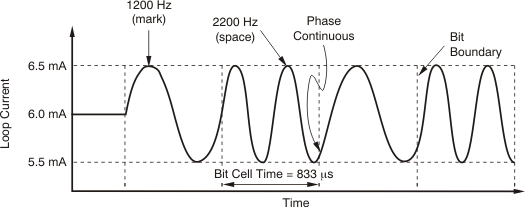ZHCSRW7 march 2023 AFE781H1 , AFE881H1
PRODUCTION DATA
- 1 特性
- 2 应用
- 3 说明
- 4 Revision History
- 5 Pin Configuration and Functions
-
6 Specifications
- 6.1 Absolute Maximum Ratings
- 6.2 ESD Ratings
- 6.3 Recommended Operating Conditions
- 6.4 Thermal Information
- 6.5 Electrical Characteristics
- 6.6 Timing Requirements
- 6.7 Timing Diagrams
- 6.8 Typical Characteristics: VOUT DAC
- 6.9 Typical Characteristics: ADC
- 6.10 Typical Characteristics: Reference
- 6.11 Typical Characteristics: HART Modem
- 6.12 Typical Characteristics: Power Supply
-
7 Detailed Description
- 7.1 Overview
- 7.2 Functional Block Diagram
- 7.3
Feature Description
- 7.3.1 Digital-to-Analog Converter (DAC) Overview
- 7.3.2 Analog-to-Digital Converter (ADC) Overview
- 7.3.3 Programmable Out-of-Range Alarms
- 7.3.4 IRQ
- 7.3.5
HART Interface
- 7.3.5.1 FIFO Buffers
- 7.3.5.2 HART Modulator
- 7.3.5.3 HART Demodulator
- 7.3.5.4 HART Modem Modes
- 7.3.5.5 HART Modulation and Demodulation Arbitration
- 7.3.5.6 HART Modulator Timing and Preamble Requirements
- 7.3.5.7 HART Demodulator Timing and Preamble Requirements
- 7.3.5.8 IRQ Configuration for HART Communication
- 7.3.5.9 HART Communication Using the SPI
- 7.3.5.10 HART Communication Using UART
- 7.3.5.11 Memory Built-In Self-Test (MBIST)
- 7.3.6 Internal Reference
- 7.3.7 Integrated Precision Oscillator
- 7.3.8 One-Time Programmable (OTP) Memory
- 7.4 Device Functional Modes
- 7.5 Programming
- 7.6 Register Maps
- 8 Application and Implementation
- 9 Device and Documentation Support
- 10Mechanical, Packaging, and Orderable Information
7.3.5 HART Interface
On the AFEx81H1, a HART frequency-shift keyed (FSK) signal can be modulated onto the MOD_OUT pin. Figure 7-23 illustrates the output current versus time operation for a typical HART interface.

| DC current = 6 mA |
To enable the HART interface, set the HART_EN bit in the MODEM_CFG register. An external capacitor, placed in series between the RX_IN pin and HART FSK source, is required to ac-couple the HART FSK signal to the RX_IN pin. The recommended capacitance for this external capacitor is 2.2 nF.
If additional filtering is required, the AFEx81H1 also support an external band-pass filter. For this configuration, use the RX_INF pin instead of RX_IN pin.